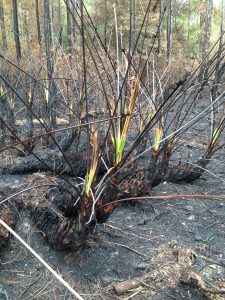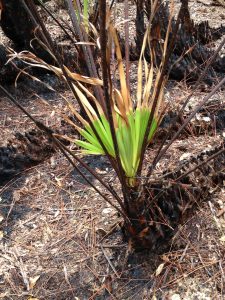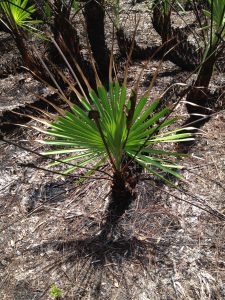Saw palmetto (Serenoa repens) is an iconic plant of Florida, often dominating the understory of pine flatwoods habitats. Not only is saw palmetto endemic to Florida and the southeastern U.S., but it has also been referred to as a keystone species! A plant as a keystone species? YES!
Keystone Species – a species on which other species in an ecosystem largely depend, such that if it were removed the ecosystem would change drastically.
For most of the year, saw palmetto fronds stand proud and upright showcasing their unique fan-shaped leaves with long, stiff, pointed leaflets and spikey leaf stems. They reflect the sun’s rays with their waxy coated, muted green and sometimes yellow leaves. From far away, saw palmetto may seem to serve little benefit to the environment other than taking up a lot of space. Upon closer inspection, saw palmetto create their own little world for numerous wildlife species big and small.
Flowers
Their unique structure with multiple stems and a thicket of leaves creates incredible shelter and cover for a variety of species. Starting in April, they bless us with masses of inflorescences containing thousands of flowers, attracting a world of pollinators. Y’all, I’m not kidding, a 2012 study documented over 2,000 insect-flower relationships just on this one species!!! Over 300 species of insects have been documented visiting saw palmetto flowers. What’s this pollinator party all about?
Believe it or not, most of these insects are actually not pollinating. Of the 228 species with a known diet, 69% are predators, meaning the flowers are not of interest to them. Most are there for potential prey, some for a potential mate, and even less for a nectar reward. Pollination only occurs by a handful of species. Love bugs are a common sight on flowering saw palmetto, but primary pollinators were determined to be bees. Bees can carry larger pollen loads than the abundant love bugs. And that’s not just the European honeybees, but our native bees too!
Fruit

Saw palmetto flowers between April and July with fruit appearing between August and October. We’ve talked a lot about their flowers and flower visitors, but let’s switch gears and talk about saw palmettos’ fruit. Their fruit (a drupe) is critically important to people and wildlife. Their drupes are used in the development of a drug known as serenoa (appropriately named) used in the treatment of bladder, prostate and urethra infections. And, in the wild kingdom, fruits are consumed by numerous species: black bear, white-tailed deer, raccoon, wild turkey, norther bob-white, gray fox, and gopher tortoise just to name a few.
Okay, I’ll name a few other species saw palmetto supports, further confirming its classification as a keystone species. Saw palmetto has been documented to provide habitat for the following listed (threatened or endangered) species:
- Crested caracara
- Florida burrowing owl
- Florida sandhill crane
- Sand skinks
- The Florida mouse (formerly listed species)
- Florida scrub jay
That’s just the listed species! Maehr and Layne (1996) documented more than 100 bird species, 27 mammals, 25 amphibians, 61 reptiles, and the 300+ insect species that utilize saw palmetto for food and/or cover. Bonus: it’s the larval plant for the monk skipper and palmetto skipper butterflies, and the nectar plant for Bartram’s scrub-hairstreak and other butterflies.
Fire?
Lastly, if you know me, I like to talk about fire any chance I get. So, let’s touch on this plant’s relationship with fire. I mentioned before these plants are often found in association with pine flatwoods habitats. Pine flatwoods are a special ecosystem, dominating the natural communities found in Florida. One characteristic of these ecosystems is they require frequent fire. I know, Florida is weird, but stay with me. The plant community found in a pine flatwood ecosystem has adapted to fire over thousands of years, so much so, they are specialists at their rapid recovery after a fire, and perhaps most notably is the saw palmetto.



Through dendrochronology (dendro = tree; chronology = the study of time) a 2006 study by Huffman looked at fire scars on cross sections of old longleaf pine stumps in northwest Florida. This examination showed 61 fire scars over a 189-year period from 1679 to 1869, meaning, on average, there was a fire every 3+ years. Okay, so you get the idea…a lot of fire, and therefore a need to be adapted to survive fire. How do palmettos do it? I’m so glad you asked!
Saw palmettos can be found resprouting new leaves within a week following a prescribed burn. As a matter of fact, one publication stated, “…[saw palmetto] thrives on frequently burned sites.” To put that into perspective, another study said, “Cover may return to pre-burn levels in as little as 1 year.” It can do this because the bulk of the plant is underground in the form of rhizomes (underground stems capable of putting out new shoots of growth). Furthermore, these rhizomes serve as a storage bank of carbohydrates, allowing the plant to pull from these reserves to initiate new plant growth following a fire.
Okay, I could seriously nerd out on saw palmetto forever, so I’ll stop here. I encourage you to check out some of the sources for this blog below if you want to learn more.
Happy Learning,
Sources:
- https://www.fnai.org/PDFs/NC/Mesic_Flatwoods_Final_2010.pdf
- https://www.conservationevidence.com/individual-study/313
- https://www.fs.usda.gov/database/feis/plants/shrub/serrep/all.html#32
- https://palms.org/wp-content/uploads/2016/05/vol47n2p95-103.pdf
- https://www.jstor.org/stable/23268495
- https://www.fnps.org/plant/serenoa-repens
 9
9
